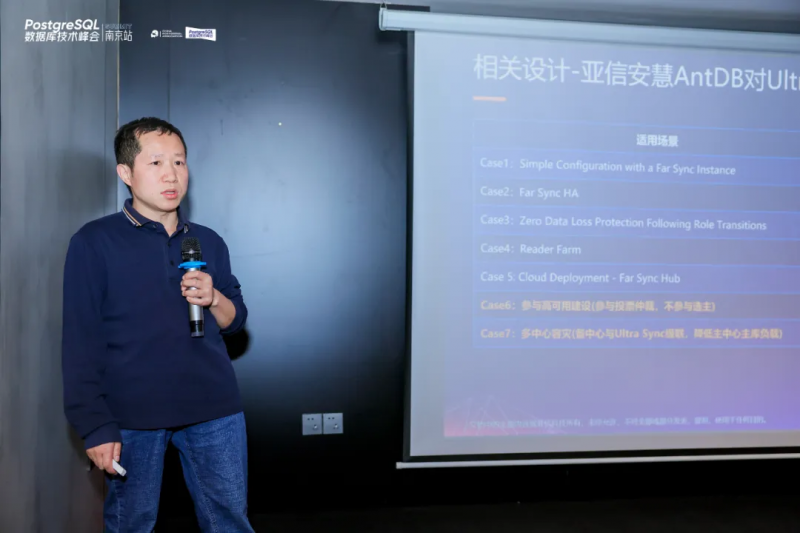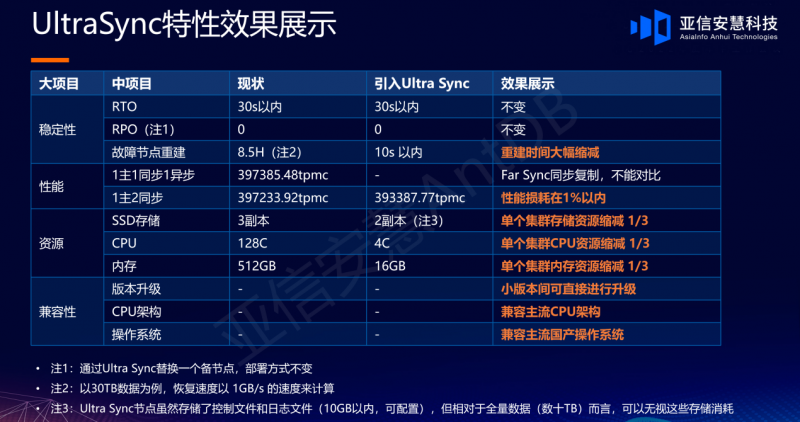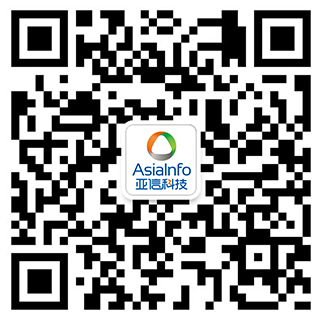On March 30th, the PostgreSQL Technology Summit, organized by the China OSS Promotion Union (COPU), was held in Nanjing, attracting R&D leaders in database developers, senior DBAs from various enterprises, and numerous technophiles. Liang Bo, the head of the AntDB-T product line R&D team at Hunan AsiaInfo Anhui Technologies Co., Ltd (hereinafter referred to as AsiaInfo Anhui) was invited to participate in the event and delivered a technical speech titled “Introduction to the UltraSync Feature of AsiaInfo Anhui's AntDB.”
The speech covered the implementation principles of the UltraSync feature at the kernel level and in terms of high availability, as well as measures to address exceptional scenarios such as single-center and multi-center disaster recovery.

Figure 1: Picture of the Live Presentation
The New UltraSync Solutions for Long-distance Disaster Recovery Scenarios Comprehensively Enhances Customers' Satisfaction
During the presentation, the head of the AntDB-T product line R&D team emphasized the significance and practical effects of the UltraSync feature, demonstrating its remarkable value in improving system performance, reducing costs, and enhancing reliability.
The introduction of the UltraSync feature aims to address the challenges faced by customers in data storage and disaster recovery. As an innovative step in the AntDB-T product line, this functional upgrade provides an effective way for customers to enhance efficiency and reduce costs. Firstly, the UltraSync feature can reduce the number of data storage replicas from three to two, significantly reducing resource consumption, which not only lowers hardware input costs but also saves human resources for maintenance and management, bringing significant economic benefits to customers in database operations and maintenance.
With the implementation principles of the UltraSync feature and its handling mechanisms for exceptional scenarios, AntDB has further strengthened its advantages in high availability. The AntDB-T product line team has successfully addressed the challenges that may arise in single-center and multi-center disaster recovery scenarios through in-depth analysis of the operating mechanisms at the kernel level, which has enhanced the stability and reliability of the system, helping customers avoid data loss and service interruptions in their daily operations. It has also enhanced their competitiveness in the market, providing strong support for their business development.
It is worth noting that the detailed explanations of the various challenges encountered during the research and development process have provided valuable experience and references for other teams in the development of similar functionalities. By sharing practical experiences and technical difficulties encountered during the development process, the AntDB-T product line team has actively promoted technological sharing and collaboration, further advancing the development and progress of the entire industry.

Figure 2: UltraSync Feature Showcase
The Actual Benefits that Operator Customers Can Get from UltraSync Feature:
1. Guarantee of Zero Data Loss: In scenarios with tens of millions of users, protecting data security is of great significance, and operator customers have strict requirements for zero data loss. The UltraSync feature has achieved this goal by deploying living examples near the primary database and indirectly transmitting logs, realizing the goal of zero data loss, which enables customers in the province to proudly announce that the RPO of their core systems is indeed zero, establishing a good reputation in the industry.
2. Cost Control and ROI Improvement: In addition to its functional advantages, the UltraSync feature has also offered practical cost benefits. Compared to traditional solutions, UltraSync feature does not require storing data files, significantly reducing disk and processing resource consumption. This allows customers in the province to meet their business needs with lower costs, enhancing their return on investment (ROI).
3. Improvement of Disaster Recovery Protection Level: The introduction of the UltraSync feature has directly elevated the disaster recovery protection capability of an operator customer in a certain province by one order of magnitude, which not only meets the business requirements of the customer but also positions it as a leader in the industry, providing it with a competitive advantage.
In summary, the introduction of the UltraSync feature has not only met the stringent requirements of the operator customer in a certain province for business continuity and data reliability, but also brought practical benefits such as cost control and enhanced disaster recovery protection level, providing strong support and guarantees for the business operation of communication services. Liang Bo also stated that the AntDB-T product line will continue to focus on technological innovation and product optimization, growing together with customers and providing them with more stable and efficient data management solutions.
This technical presentation demonstrated once again the technical strength and innovation capabilities of AsiaInfo Anhui's AntDB-T product line in the database field that it can provide customers with more comprehensive and high-quality services.
In the future, the company will continue to invest in research and development and collaborate with customers to drive the next phase of database management.
About AsiaInfo Anhui's AntDB
Founded in 2008, AsiaInfo's AntDB has been deployed in 24 provinces, autonomous regions, and municipalities across China based on operators' core systems. It has product features such as high performance, elastic scalability, and high reliability with a capability of handling millions of core communication transactions per second at peak values, ensuring the stable and continuous operation of the system over a decade, and has been successfully commercialized and implemented in industries such as communications, finance, transportation, energy sources, and the IoT.





